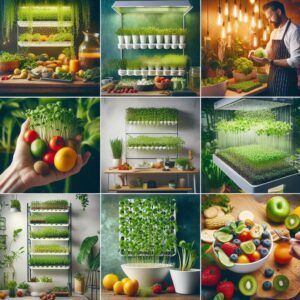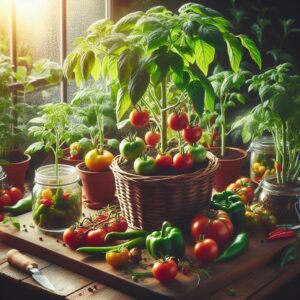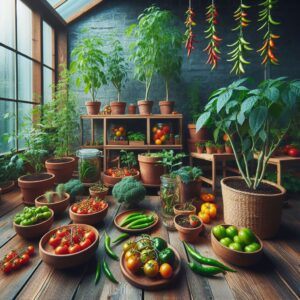
Welcome to from roots to shoots the world of indoor gardening, if like me (Mitch) you can’t enjoy outdoor fruit and vegetables all year round you’re in luck. We are going to dive into, how to grow fruit and vegetables indoors.
Why Grow Fruit And Vegetables Indoors
Indoor gardening allows you to enjoy fresh produce throughout the entire year, irrespective of external weather conditions. This constant supply of fruits and vegetables ensures a steady source of nutrition for you and your family, we absolutely love it. Indoors, you have precise control over environmental factors such as light, temperature, and humidity. This control enables you to create optimal conditions for plant growth, resulting in healthier and more productive crops. Homegrown produce is renowned for its superior freshness and flavor. Picking fruits and vegetables at their peak ripeness, just moments before consumption, ensures a taste that surpasses many store-bought alternatives. Indoor gardens add a touch of nature to your living space, enhancing its aesthetic appeal. Lush greenery, colorful flowers, and ripening fruits contribute to a visually pleasing and inviting environment.
Choose The Right Plants
Select fruits and vegetables that are well-suited for indoor cultivation.
Ideal choices include:
Herbs: Basil, Parsley, Chives, Mint, Thyme, Cilantro Coriander
Leafy Greens: Spinach, Lettuce, Kale, Swiss Chard, Arugula
Tomatoes: Compact or dwarf tomato varieties are suitable for indoor containers such as

- Balcony: As the name suggests, this tomato variety is suitable for balcony or container gardening. It’s a determinate bush-type plant, meaning it has a compact growth habit and doesn’t require staking.
- Patio Princess: Another compact determinate variety, Patio Princess, is designed for small spaces. It produces small to medium-sized tomatoes and is well-suited for containers or hanging baskets.
- Micro Tom: This is one of the smallest tomato varieties available, reaching only 6-8 inches in height. It’s a determinate cherry tomato, making it ideal for indoor growing in small pots.
- Bush Early Girl: A determinate bush-type tomato, Bush Early Girl is known for its early harvest and compact growth habit. It’s a good choice for indoor gardening, especially if you have limited space.
- Cherry Cascade: This trailing cherry tomato variety is well-suited for hanging baskets or containers. It has a cascading growth habit, making it visually appealing, and produces sweet cherry tomatoes.
- Window Box Roma: If you’re interested in growing Roma tomatoes indoors for sauces or paste, Window Box Roma is a compact determinate variety that is well-adapted to container gardening.
- Tiny Tim: This is a dwarf cherry tomato variety that is perfect for small indoor spaces. It’s compact, reaching about 12-18 inches in height, and produces small, flavorful cherry tomatoes.
Peppers: Dwarf bell peppers or chilli peppers can be grown indoors. Head over here for more on growing chillies in containers Click Here (you won’t leave this page)
- Thai Hot Pepper: Thai peppers are known for their heat, and the Thai Hot Pepper is a compact plant that can be grown indoors. It produces small, fiery red peppers and is well-adapted to container gardening.
- Numex Twilight: This ornamental chili pepper is suitable for indoor growing due to its compact size and colorful appearance. The peppers change from purple to yellow, orange, and then red as they mature.
- Patio Fire: Patio Fire is a miniature bell pepper variety that is ideal for indoor containers. It has a compact growth habit and produces small, colorful bell peppers that are perfect for snacking.
- Cherry Bomb Pepper: A moderately hot chilli, the Cherry Bomb Pepper has a compact growth habit and produces round, red peppers. It’s suitable for indoor cultivation and works well in containers.
- Filius Blue (Purple Chilli): Filius Blue is a small, ornamental chili with purple foliage and upright growth. The peppers start purple and mature to red, adding visual interest to your indoor garden.
- Basket of Fire: This is a compact chili pepper variety that works well in hanging baskets or containers. It produces small, hot peppers that are perfect for adding spice to your dishes.
- Red Mini Bell: As the name suggests, Red Mini Bell is a small bell pepper variety that is well-suited for indoor containers. It produces sweet, red peppers and has a compact growth habit.
- Lemon Drop Chilli (Aji Lemon): This is a hot, citrus-flavored chili that is well-suited for indoor growing. It has a compact growth habit and produces small, yellow, lantern-shaped peppers.
Strawberries:

- Eversweet Everbearing Strawberry: This variety is known for its sweet taste and ability to produce fruit throughout the growing season. Eversweet strawberries are compact and suitable for growing in containers.
- Temptation Everbearing Strawberry: Temptation is a day-neutral strawberry variety, meaning it produces fruit continuously regardless of day length. It’s well-adapted to container gardening and produces sweet berries.
- Tristan Strawberry: Tristan is a compact everbearing strawberry that is well-suited for indoor cultivation. It produces small, flavorful berries and works well in hanging baskets or containers.
- Quinault Everbearing Strawberry: Quinault is an everbearing variety that is known for its large and sweet berries. It’s a good choice for indoor gardening due to its compact growth habit.
- Fraise des Bois (Woodland Strawberry): This alpine strawberry variety is well-suited for containers and hanging baskets. It has a trailing growth habit and produces small, aromatic berries.
- Seascape Everbearing Strawberry: Seascape is a day-neutral strawberry that produces fruit continuously. It has a compact growth habit and is suitable for growing in containers or small spaces
- Alpine Strawberries (Fragaria vesca): Alpine strawberries are known for their small size and intense flavor. They are well-suited for containers and hanging baskets. ‘Mignonette’ and ‘Alexandria’ are popular alpine varieties.
Citrus trees: Dwarf citrus trees, such as dwarf lemon or lime, can thrive indoors with proper care and sunlight.
Micro greens: Various microgreens, like radish, broccoli, and sunflower, are easy to grow indoors and provide a quick harvest.

How To Grow Fruit And Vegetables indoors
Choose appropriate containers. Use containers with good drainage to prevent overwatering. Choose pots that are large enough to accommodate the plant’s root system but not excessively large, as this can lead to waterlogging. Consider the mature size of the plant when selecting containers. Use a well-draining potting mix tailored to the needs of your plants. Consider adding perlite or vermiculite to improve aeration and drainage.
Provide adequate light. Place your indoor garden near a window to maximize natural light exposure. If natural light is insufficient, supplement with artificial light sources, such as full-spectrum LED or fluorescent grow lights. Position lights close to the plants to mimic the intensity of sunlight. Most indoor plants thrive in temperatures between 60-75°F (15-24°C). Maintain consistent temperatures and avoid exposing plants to drafts. If your indoor environment is dry, consider using a humidifier or placing trays of water near the plants. Rotate your pots regularly to ensure all sides of the plants receive equal light exposure. This helps prevent leaning or uneven growth. Make sure to have nice airflow.
Water and fertilising. Allow the top inch of soil to dry out before watering. Water thoroughly but ensure excess water can drain away. Use a saucer under pots to catch excess water and prevent root rot. Indoor plants benefit from regular feeding. Use a balanced, water-soluble fertilizer during the growing season, following the package instructions. Adjust the frequency based on the needs of your specific plants. Some fruiting plants may require assistance with pollination indoors. Gently shake the plants or use a small brush to transfer pollen between flowers. Regularly prune your plants to encourage bushier growth and remove dead or diseased parts. For larger plants, consider using stakes or trellises to support growth. Head over here for all you need to know on The Best Organic Fertilizers
Watch for pests and diseases. Keep an eye out for pests like aphids, spider mites, and whiteflies. Use organic pest control methods such as neem oil or insecticidal soap. Remove any affected leaves promptly.
Harvesting. Harvest fruits and vegetables when they reach maturity. Regular harvesting encourages continuous production. Be gentle during the harvest to avoid damaging the plants. By following these steps and tailoring them to the specific needs of your chosen plants, you can create a successful indoor garden that provides a bountiful harvest of fresh and nutritious fruits and vegetables throughout the year.
The decision to grow fruits and vegetables indoors presents a host of compelling advantages. Beyond the convenience of having a year-round supply of fresh, homegrown produce, indoor gardening offers a solution to space constraints, promotes environmental sustainability, and empowers individuals to embrace a healthier, self-sufficient lifestyle. By cultivating a thriving indoor garden, you not only enjoy the flavors of your labor but also contribute to a greener, more sustainable future. So, whether you’re a seasoned gardener or a novice with a green thumb in the making, the benefits of growing fruits and vegetables indoors are ripe for the picking, bringing nature’s bounty directly into your living space.
Please share some stories and drop me a comment with any questions i’m more than happy to help
Happy cultivating!
Mitch
Our website contains affiliate links. This means if you click and make a purchase, we may receive a small commission. Don’t worry, there’s no extra cost to you. It’s a simple way you can support our mission to bring you quality Gardening Tips.
Last Updated on January 29, 2025 by Mitch

